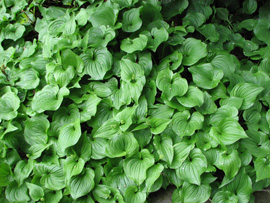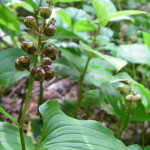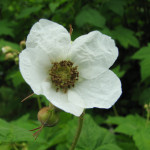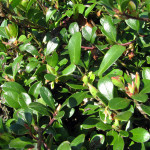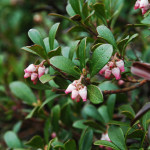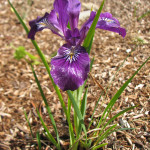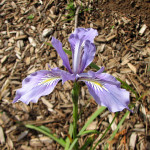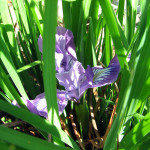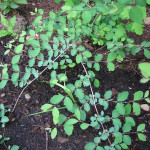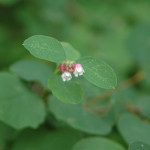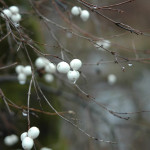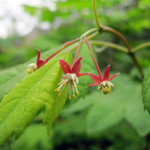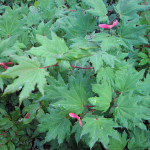Maianthemum dilatatum
The plant produces an erect, unbranched stem up to about 40 centimeters tall. A non-flowering shoot bears one smooth, waxy, shiny leaf up to 10 centimeters long and 5 to 8 broad, hence its scientific name (dilatatum means ‘broad’). On plants that are flowering, 2 or 3 leaves are produced oppositely on the stems. The leaf is oval in shape with a heart-shaped base. This attractive groundcover can spread vigorously when in planted in favorable conditions.
The inflorescence is an erect raceme with star-shaped white flowers. They each have four petals and four stamens. After fertilization the fruit produced is a berry 6 millimeters in diameter. The berry is speckled red when immature and solid red when ripe. Each has 1 to 4 seeds.
- Light Requirements: Part Shade, Full Shade
- Water Requirements: Moist
- Ease of Growing: Easy to grow
- Growth Rate: Moderate
- Spreads: Yes
- Wildlife Support: Birds or Mammals
- Fire-resistant: Yes
- Edible:
- Mature Height: 1ft
- Mature Width:2-3ft
Thimbleberry

Rubus parviflorus
Thimbleberry (Rubus parviflorusis) is a dense, spreading deciduous shrub that grows 4-6 feet tall and wide. It is a friendly plant with large, soft, fuzzy leaves and no thorns or prickles. The white flowers have five petals and a pale yellow center. The delicious fruits are like large, soft, velvety raspberries.
Thimbleberries are used by many kinds of wildlife year round. They are important sources of nectar, nest material, and winter shelter for native bees. Yellow-banded sphinx moths eat the leaves when young, and the berries are eaten by dozens of species.
These thicket-forming plants typically grow along roadsides, railroad tracks, and in forest clearings, commonly appearing soon after clear cuts and forest fire areas. In urban areas, thimbleberries can form a natural hedge at the back of the garden or provide cover on sunny, dry hillsides.
- Light Requirements: Full Sun, Part Shade, Full Shade
- Water Requirements: Dry, Moist
- Ease of Growing: Easy to grow
- Growth Rate: Moderate
- Spreads: Yes
- Wildlife Support: Pollinators, Hummingbirds, Pest-eating Insects, Birds or Mammals
- Fire-resistant: No
- Edible: Yes
- Mature Height: 4-6ft
- Mature Width:3-6ft
Kinnikinnick
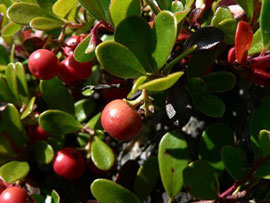
Arctostaphylos uva-ursi
Kinnikinnick is a species of Arctostaphylos, one of several related species referred to as bearberry or kinnikinnick. The distribution is circumpolar, widespread in northern latitudes, confined to high altitudes further south. In North America, it ranges from arctic Alaska, Canada and Greenland south to California.
It is a small, spreading procumbent woody shrub 5-30 cm high. The leaves are evergreen, remaining green for 1-3 years before falling. The fruit is a red berry. The leaves are shiny, small, and feel thick and stiff. In spring, kinnikinnick produces white or pink flowers. They are a common plant on Jack pine sites. They grow well in dry, sunny gardens.
Uses
Kinnikinnick has historically been used for medicinal purposes. It contains the glycoside arbutin, which has antimicrobial properties and acts as a mild diuretic. It has been used for urinary tract complaints, including cystitis and urolithiasis.
- Light Requirements: Full Sun
- Water Requirements: Dry, Moist
- Ease of Growing: Easy to grow
- Growth Rate: Fast
- Spreads: Yes
- Wildlife Support: Pollinators, Hummingbirds, Pest-eating Insects, Birds or Mammals
- Fire-resistant: Yes
- Edible: No
- Mature Height: 5-8in.
- Mature Width:2-15ft
Tall Oregon Grape

Mahonia aquifolium (Berberis aquifolium)
Tall Oregon grape (Mahonia aquifolium) is the state flower of Oregon. The plant is not related to grapes, but gets the name from the purple clusters of berries it produces every fall. Its sharply pointed leaves resemble holly. The bright yellow clusters of flowers in April and May are both a lovely sign of spring, and a welcome sources of nectar for early pollinators including mason bees and bumblebees.
Painted lady butterflies, half-white carpet moths, mining bees, and other insects also use the flowers for food. The berries are eaten by many wildlife, including robins, waxwings, juncos, sparrows, and towhees, as well as foxes, coyotes, and raccoons.
Tall Oregon grape is well suited for low-maintenance plantings or loose evergreen hedges. It grows 5-8 feet tall depending on conditions, so in the garden it serves as a good evergreen backdrop, especially when combined with salal, sword fern, and evergreen hucklebery. Tall Oregon grape tolerates poor soils and summer drought, especially if it has some shade.
- Light Requirements: Full Sun, Part Shade
- Water Requirements: Dry, Moist
- Ease of Growing: Easy to grow
- Growth Rate: Moderate
- Spreads: Yes
- Wildlife Support: Pollinators, Hummingbirds, Pest-eating Insects, Birds or Mammals
- Fire-resistant: Yes
- Edible: Yes
- Mature Height: 5-8ft
- Mature Width:2-8ft
Oregon iris

Iris tenax
Iris tenax is a species of Iris native to southwestern Washington and northwestern Oregon. It is known as the tough-leaved iris or Oregon iris. It occurs along roadsides and in grasslands and forest openings at low to middle elevations. One subspecies is also known from northern California.
Like most irises, it has large and showy flowers. The flowers bloom in mid to late spring and are usually lavender-blue to purple, but blooms in white, yellow, pink, and orchid shades are known to sometimes occur.
- Light Requirements: Full Sun, Part Shade
- Water Requirements: Dry, Moist
- Ease of Growing: Moderate
- Growth Rate: Moderate
- Spreads:
- Wildlife Support: Hummingbirds, Pest-eating Insects, Birds or Mammals
- Fire-resistant: Yes
- Edible:
- Mature Height: 1-2ft
- Mature Width:1-2ft
Snowberry
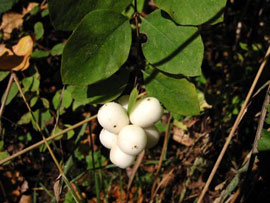
Symphoricarpos albus
Few plants are as aptly named as snowberry. Small bell-like pink flowers give way to scattered clusters of white berries in late summer, which stay on the delicate, arching branches through the fall and much of winter. The small, pale green oval leaves turn a soft yellow in the fall.
Snowberries are at their best in the landscape when combined with other plants. They bring an airy lightness to the understory that contrasts well with the thick evergreen leaves of salal and low Oregon grape, the red stems of red osier dogwoods, and the feathery green foliage of Western hemlock and Western redcedar.
The berries are eaten late in winter by thrushes, towhees, robins, waxwings, and grosbeaks. Anna’s and rufous hummingbirds are attracted to the flowers, as are many species of native bees. Snowberry also provides food for the young of vashti sphinx moths and is generally good cover for wildlife.
Snowberry is tolerant of a wide variety of growing conditions, spreads easily, and makes an excellent addition to any garden.
- Light Requirements: Full Sun, Part Shade, Full Shade
- Water Requirements: Dry, Moist
- Ease of Growing: Easy to grow
- Growth Rate: Fast
- Spreads: Yes
- Wildlife Support: Pollinators, Hummingbirds, Pest-eating Insects, Birds or Mammals
- Fire-resistant: Yes
- Edible: No
- Mature Height: 3-6ft
- Mature Width:2-4ft
Noble Fir
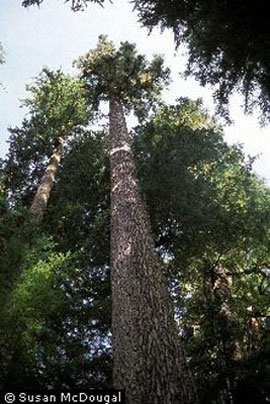
Abies procera
Noble fir (Abies procera) is native to the Cascade Range and Coast Range mountains of northwest California, western Oregon and western Washington.
It is a large evergreen tree typically up to 40-70 m tall and 2 m trunk diameter (rarely to 89 m tall and 2.7 m diameter), with a narrow conic crown. The bark on young trees is smooth, grey, and with resin blisters, becoming red-brown, rough and fissured on old trees. The glaucous blue-green needle-like leaves are 1-3.5 cm long. They are arranged spirally on the shoot, but twisted slightly to curve up above the shoot. The cones are erect, 11-22 cm long; they do not fall to the ground intact, but instead ripen and disintegrate to release winged seeds in fall.
It is a high altitude tree, typically occurring at 300-1,500 m altitude, only rarely reaching tree line.
Uses
Noble Fir is a popular Christmas tree. The wood is used for general structural purposes and paper manufacture.
- Light Requirements: Full Sun, Part Shade
- Water Requirements: Moist
- Ease of Growing: Easy to grow
- Growth Rate: Moderate
- Spreads: No
- Wildlife Support: Birds or Mammals
- Fire-resistant: No
- Edible: No
- Mature Height: 250ft
- Mature Width:30ft
Vine Maple
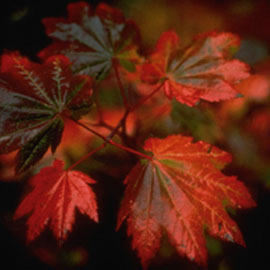
Acer circinatum
Vine maple (Acer circinatum) commonly grows as a large open shrub or small tree reaching 10-25 feet tall. It typically grows in the shady forest understory but is sometimes found out in the open. Like many plants, it typically gets taller in the shade and stays more compact in the sun.
Like all maples, the branches and leaves grow in pairs off the stem, known as “opposite branching.” Leaves are 3-14 cm long and broad, and thinly hairy on the underside. They are palmately lobed with 7-11 lobes, which are pointed with coarsely toothed margins. The flowers make a small but dramatic show in spring, blooming a bright red and whitish-green from May – June. The fruit is a two-seeded winged fruit called a samara, starting green then turning reddish-brown as they ripen. The leaves turn bright yellow to orange-red in fall and provide some of our most vivid native fall color.
Vine maples are important trees for wildlife. They provide nesting sites and cover for many birds and mammals. Vireos weave basket-like nests that hang in the forks of the branches. Birds use the seed stalks and leaves for nest building. Squirrels, chipmunks and birds eat the seeds, and the caterpillars of the brown tissue moth and Polyphemus moth forage on the leaves.
Vine maple grows best in part shade and moist soils. It can live out in the open but exposed leaves may burn and turn reddish in the afternoon sun. This is a beautiful specimen plant for a shady corner, or a tall screen to soften the side of a house. Pair it with snowberry and ferns for year-round interest.
- Vine maple is fire-resistant – remember, though, being fire-resistant does not mean it will not burn!
- Light Requirements: Full Sun, Part Shade, Full Shade
- Water Requirements: Moist
- Ease of Growing: Easy to grow
- Growth Rate: Moderate
- Spreads: No
- Wildlife Support: Pollinators, Pest-eating Insects, Birds or Mammals
- Fire-resistant: Yes
- Edible: No
- Mature Height: 20-25ft
- Mature Width:15-20ft

